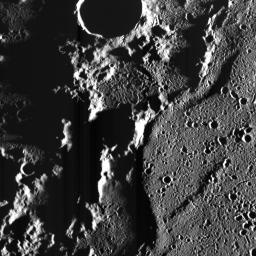
|
Ridges in the Dark
- Click the image above for a larger view
- Full-Res JPEG (1014 x 1014) (199.0 kB)
- Full-Res TIFF (1014 x 1014) (1.0 MB)
Caption:
The Goethe impact basin hosts some of the most remarkable tectonic deformation observed on Mercury -- but this deformation is not restricted to its interior. A number of wrinkle ridges line its perimeter, examples of which we have seen before . In this scene, several ridges and lobate-like landforms (that are likely tectonic but resemble lava flow fronts) occur along the basin's northern margin.
This image was taken when the Sun was very close to the horizon, which serves to lengthen shadows and emphasize topographic relief. Although the basin's interior is filled with smooth plains , low-Sun images show even smooth plains to be pock-marked with small craters. Nonetheless, the lighting in this scene clearly illustrates the difference in texture between Goethe's (relatively) smooth plains infill and the much more rugged intercrater plains that surround the basin.
This image was acquired as part of MDIS's campaign to image within regions of permanent shadow in ice-bearing polar craters. Imaging with the WAC broadband clear filter, which has a bandwidth of 600 nanometers and is used for calibration imaging of stars, has the potential to reveal details of shadowed surfaces that are weakly illuminated by scattered sunlight. NAC images obtained with long exposure times are also acquired to seek details within shadowed regions. A variety of image exposure times and viewing conditions are employed to maximize the opportunity to resolve surface features of areas in permanent shadow.
Date acquired:
January 28, 2014
Image Mission Elapsed Time (MET):
33025370
Image ID:
5641760
Instrument:
Wide Angle Camera (WAC) of the Mercury Dual Imaging System (MDIS)
Center Latitude:
84.3°
Center Longitude:
290.8° E
Resolution:
72 meters/pixel
Scale:
This scene is about 57 km (35 mi.) across
Incidence Angle:
88.1°
Emission Angle:
26.5°
Phase Angle:
83.9°
North is to the top left of the image.
Background Info:
The MESSENGER spacecraft is the first ever to orbit the planet Mercury, and the spacecraft's seven scientific instruments and radio science investigation are unraveling the history and evolution of the Solar System's innermost planet. MESSENGER acquired over 150,000 images and extensive other data sets. MESSENGER is capable of continuing orbital operations until early 2015.
For information regarding the use of images, see the MESSENGER image use policy .
Cataloging Keywords:
| Name | Value | Additional Values |
|---|---|---|
| Target | Mercury | |
| System | ||
| Target Type | Planet | |
| Mission | MESSENGER | |
| Instrument Host | MESSENGER | |
| Host Type | Orbiter | |
| Instrument | Mercury Dual Imaging System (MDIS) | |
| Detector | Wide Angle Camera (WAC) | |
| Extra Keywords | Crater, Grayscale, Impact, Radio, Shadow | |
| Acquisition Date | ||
| Release Date | 2014-02-19 | |
| Date in Caption | 2014-01-28 | |
| Image Credit | NASA/Johns Hopkins University Applied Physics Laboratory/Carnegie Institution of Washington | |
| Source | photojournal.jpl.nasa.gov/catalog/PIA18037 | |
| Identifier | PIA18037 | |
